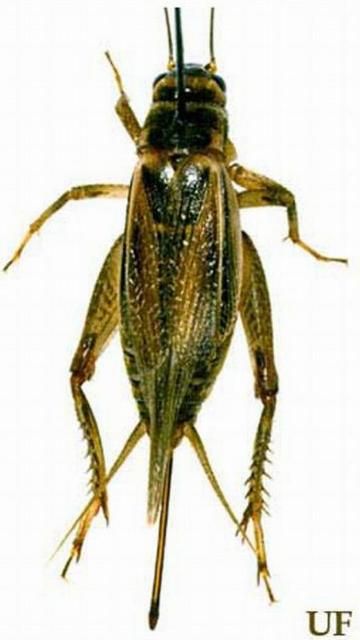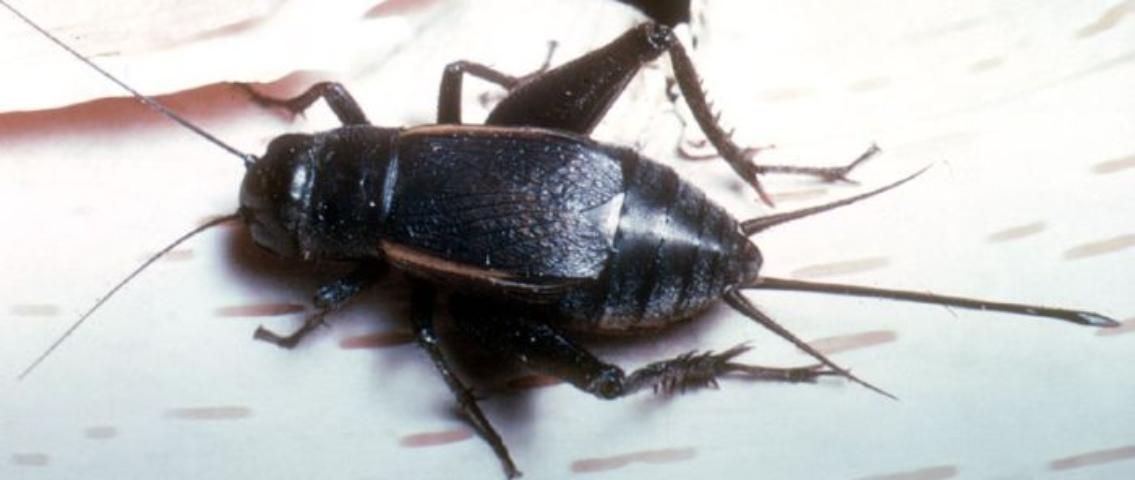
Crickets are sometimes nuisances in buildings and can damage fabrics and other materials. Crickets are often attracted to lights around a building and can invade a structure in large numbers. Once they are inside a building, crickets can hide behind baseboards, under stairs, in closets, garages, attics, as well as any storage area with debris and clutter.
The males produce a chirping sound by rubbing their front wings together, which can be annoying after a period of time. They may also damage fabrics and are more attracted to clothing and fabrics soiled with perspiration or other stains. They are especially destructive to silks and wool.
Crickets belong to the insect order Orthoptera and are related to grasshoppers. These insects are hemimetabolous, meaning the young (nymph) resemble the adults, except the young do not have functional wings. Both young and adult crickets have similar feeding habits and are omnivorous.
The most common crickets to invade buildings include the house cricket and the field cricket, which are very similar in appearance. House cricket adults (Figure 1) range in length from 3/4 to 1 inch (19 to 25 mm) and may be light yellowish brown with three dark bands on the head, or solid, shiny black. This species has slender antennae that are longer than its body. Field cricket adults are more robust and slightly larger, ranging from 1/2 to 11/4 inch (13 to 32 mm) in length, and are brown or black (Figure 2).


Credit: Purdue University
Females of both species have a long, thin ovipositor projecting from the tip of the abdomen. The ovipositor is used to deposit eggs into soil or vegetation. Most crickets overwinter as eggs, hatching in the spring. The field cricket matures into an adult in about 90 days.
Management Guidelines for Crickets
The key to managing crickets in buildings is exclusion. Cracks, crevices and other openings on the outside that provide access to the building should be sealed. Caulk, screen, or otherwise seal cracks, crevices, vents, and electrical and plumbing entrances, and repair window screens and weather stripping around doors to prevent crickets from entering. Behind or under heavy furniture and appliances or in other inaccessible areas, it may be possible to remove crickets using a strong vacuum cleaner. Weeds and debris, such as wood piles and dense vegetation, around the outside of the building should be removed to eliminate attractive habitats. Change outside lighting to sodium vapor lights or yellow incandescent lights that are less attractive to crickets (and other insects). Garbage and other refuse that serves as food should be stored in containers with tight lids and elevated off the ground on platforms or bricks.
Insecticides should be used only when exclusion and sanitation cannot accomplish control quickly enough to stop damage within a reasonable time. Use liquid sprays of an insecticide registered for use indoors as a spot treatment in cracks and crevices and other areas where crickets may hide. Sorptive powders may also be blown into inaccessible areas. Liquid sprays can also be applied around the perimeter of a building or in other outdoor areas. Avoid using outdoor spray materials indoors, unless the label states that this is permissible. Insecticide impregnated baits or granular formulations of certain materials may also be used outdoors around buildings for cricket control. Some baits can be applied indoors, but only to areas inaccessible to children or pets. Granules are suitable in lawns and other areas subject to moisture or frequent watering. Do not use baits or granules if children or pets can gain access to them. Baits formulated for mole cricket or roach control may be used for house and field cricket control.
Cricket infestations are usually seasonal. Most often problems occur during the fall as evenings become cooler and the insects seek buildings for warmth and shelter. Because of this, applications of long-residual insecticides are not usually needed indoors for adequate control.